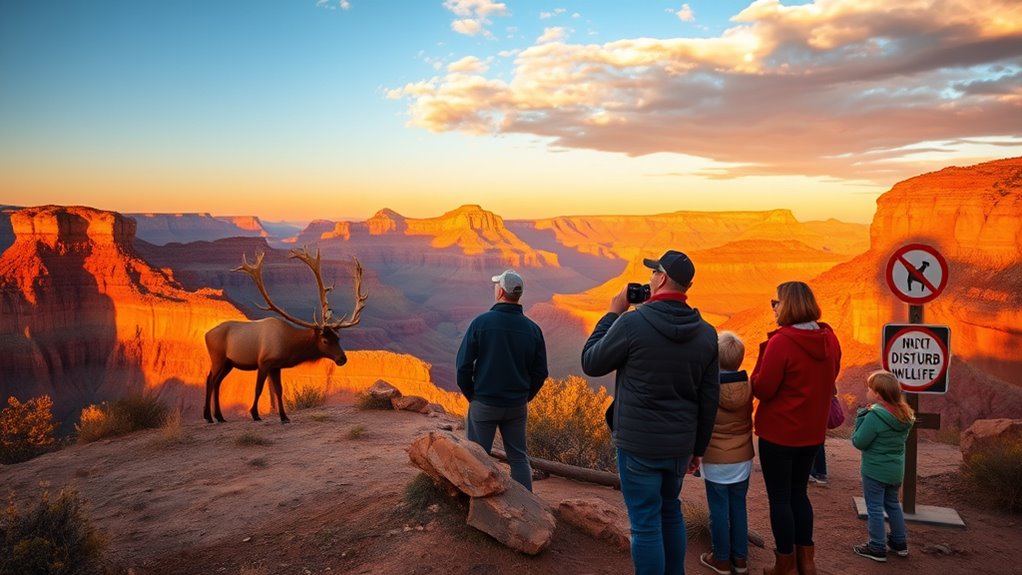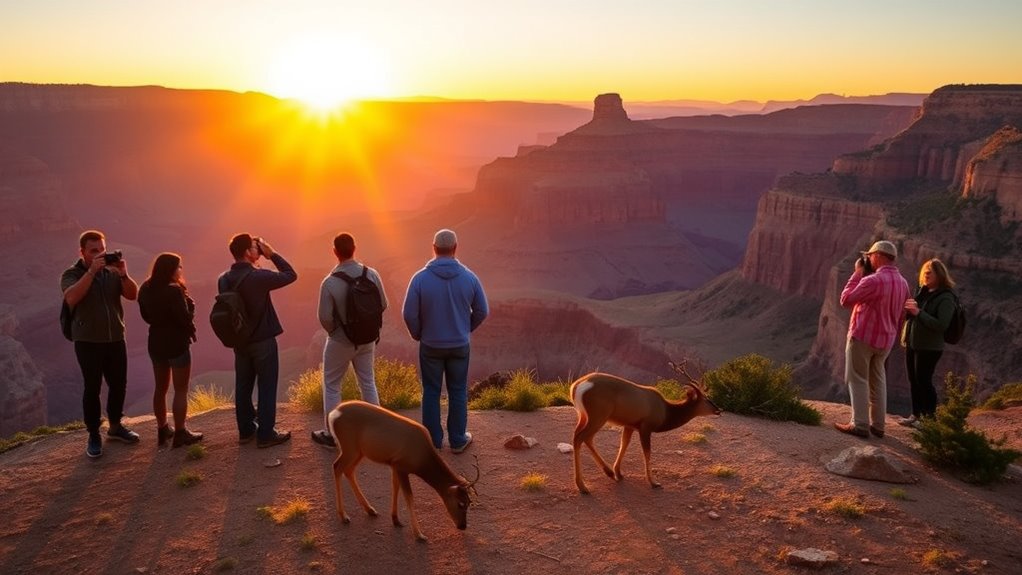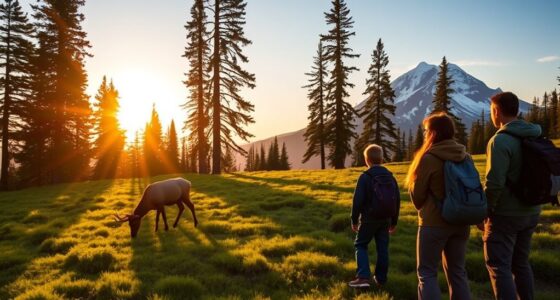When viewing wildlife in Grand Canyon National Park, always respect animals and their habitats. Stay at least 100 yards away from large mammals, and use binoculars for closer looks. Avoid feeding wildlife, as it disrupts their natural behaviors and can create harmful dependencies. Keep noise levels down to prevent startling animals. By following these guidelines, you contribute to a healthier ecosystem and ensure that future generations can enjoy the beauty of nature. There’s more to explore on this topic!
Key Takeaways
- Maintain a distance of at least 100 yards from large mammals to ensure safety for both you and the wildlife.
- Use binoculars or zoom lenses for close views without disturbing animals in their natural habitat.
- Avoid feeding wildlife to prevent dependency on human food and preserve their natural foraging instincts.
- Keep noise levels low and refrain from sudden movements to minimize stress on animals during observation.
- Respect the natural environment by appreciating wildlife quietly and responsibly, fostering ecological balance in the park.

When you venture into nature to observe wildlife, it’s essential to remember that your actions can impact both the animals and their habitats. At Grand Canyon National Park, you’ll find a rich diversity of wildlife, from mule deer to numerous bird species. However, to ensure these creatures thrive, it’s vital to follow wildlife viewing etiquette. One of the most crucial guidelines is to avoid feeding wildlife. While it might be tempting to toss a few snacks their way, doing so disrupts their natural foraging behavior and can lead to dependency on human food. Animals that become reliant on people for meals can lose their instinctual behaviors, which can harm their survival.
Observing wildlife requires mindfulness; avoid feeding animals to protect their natural behaviors and habitats.
Moreover, feeding wildlife can alter their natural habitats. When animals congregate around human food sources, they may overgraze or damage vegetation, leading to long-term ecological issues. Instead of feeding them, observe their natural behaviors from a distance. This way, you not only help preserve their instincts but also get a more authentic glimpse into their lives. Remember, maintaining distance is key to a respectful wildlife encounter. The National Park Service recommends observing animals from at least 100 yards away, especially larger mammals like bears and bison. Keeping this safe distance not only protects you but also reduces stress on the animals.
When you’re out there, keep your noise levels down too. Loud sounds can startle wildlife, making them flee or hide. Instead, embrace the quiet beauty of nature and let the animals go about their business without disturbance. If you’re lucky enough to spot an animal, take a moment to appreciate it without intruding on its space. Use binoculars or a camera with a zoom lens to get a closer look while still respecting their boundaries. Advanced segmentation techniques can help enhance your wildlife viewing experience by allowing you to understand animal behavior patterns better.
Your respect for wildlife and their home speaks volumes about your appreciation for nature. By adhering to these etiquette rules, you contribute to the health of the ecosystem and ensure that future visitors can enjoy the same experiences. So, the next time you wander through Grand Canyon National Park, take a moment to reflect on how your actions affect the wildlife around you. By maintaining distance and avoiding the temptation to feed them, you play a vital role in protecting these magnificent creatures and their habitat. Your mindful approach to wildlife viewing creates a sustainable environment for all.
Frequently Asked Questions
What Are the Best Times for Wildlife Viewing in the Grand Canyon?
The best viewing times for wildlife in the Grand Canyon are early morning and late afternoon, when animals are most active. Spring and fall offer peak seasonal wildlife activity, as many species emerge from hibernation or migrate. During these times, you’re likely to spot deer, bighorn sheep, and various bird species. Don’t forget to bring binoculars to enhance your experience and stay quiet to increase your chances of seeing these fascinating creatures!
Can I Bring My Pet While Wildlife Viewing?
You can’t bring your pet while wildlife viewing. Pets can cause wildlife disturbance, scaring animals and disrupting their natural behavior. Plus, your pet’s safety is at risk, as they might encounter wild animals or rough terrain. It’s best to leave your furry friend at home or in a pet-friendly area. Enjoy the beauty of the Grand Canyon and its wildlife without the added stress of managing a pet during your visit.
Are There Specific Trails for Wildlife Observation?
Yes, there are specific trails designated for wildlife observation. You’ll want to check the park’s trail regulations to guarantee you’re on the right paths. Popular trails like the Rim Trail and Bright Angel Trail offer great opportunities to spot various animals. Remember, staying on marked trails helps protect both you and the wildlife, so always follow guidelines. Enjoy your adventure and keep your eyes peeled for the region’s unique creatures!
How Do I Report Injured or Sick Wildlife?
When you spot injured or sick wildlife, it’s like finding a wounded soldier in a battlefield. You need to act quickly. First, contact the local wildlife rescue organization or park ranger. They’ve got the training and resources to help. Keep a safe distance and don’t try to handle the animal yourself. Always have the emergency contact numbers handy—it’s essential for ensuring the wildlife gets the care it needs as soon as possible.
What Should I Do if I Encounter a Dangerous Animal?
If you encounter a dangerous animal, stay calm and avoid sudden movements. Back away slowly without turning your back on the animal. Keep your distance and don’t provoke it. If the situation escalates, use your emergency procedures: call for help or alert park rangers. Remember, wildlife safety is essential; always prioritize your safety and that of others. Educate yourself about the specific animals in the area to stay prepared.
Conclusion
When you step into the Grand Canyon, think of yourself as a gentle breeze, touching the landscape without leaving a trace. Respect the wildlife you encounter, as they are the heartbeat of this majestic place. Keep your distance, allowing them to flourish in their natural dance. Just like the river that carves the canyon’s depths, your actions can shape the experience for future visitors. Embrace this responsibility, and let your presence be a whisper, not a roar.










